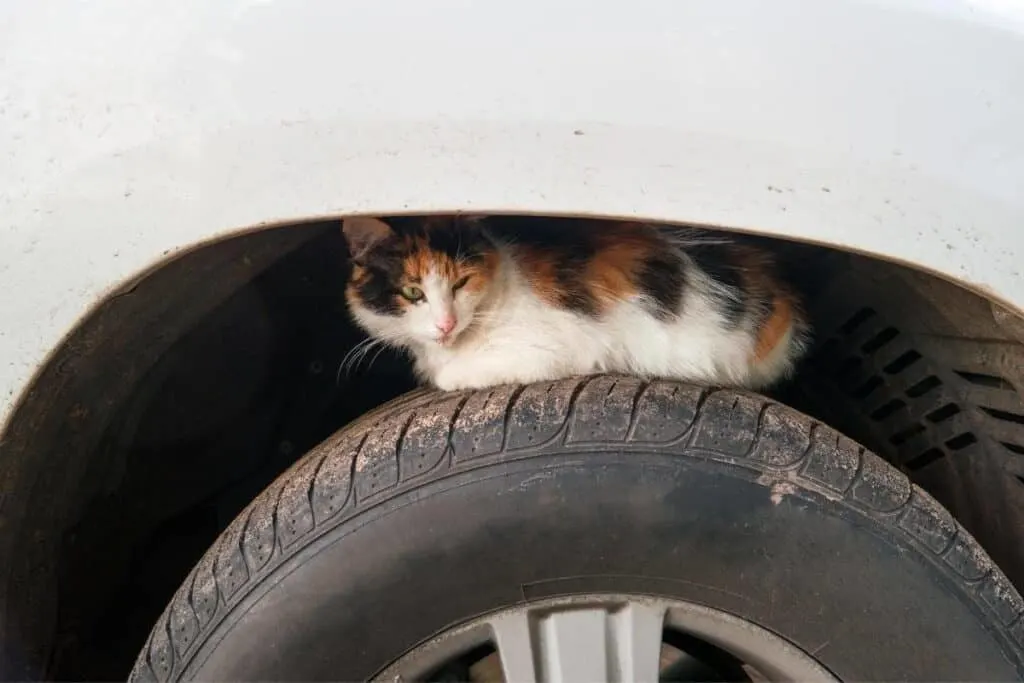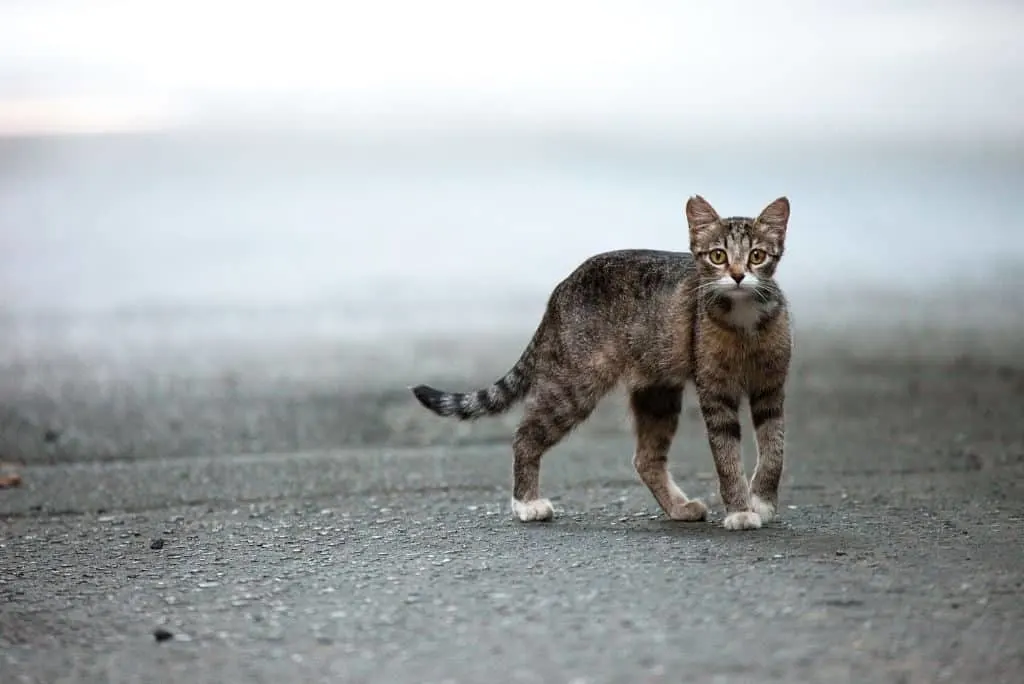You might have seen one hanging around your local store, stalking across your lawn, or even visiting your front door. Perhaps they have even started meowing at you, before running swiftly away when you approach. If so, you might be wondering about taming feral cats and kittens — is it possible and will it help?
Feral cats are the feline homeless.
They live their entire lives outside, are usually born in the wild or abandoned very young and have often had minimal contact with humans. It’s hard to keep an accurate record, but scientific data estimates there are around 70 million of these feral cats and kittens wandering around America.
As animal lovers here at Fluffy Kitty, we know what it’s like to start worrying about any feral visitors you receive. Especially if you encounter them surviving in cold weather or in a seemingly unsafe environment.
You might start to wonder how you can help – can feral cats be tamed? Can feral cats become pets? And how do you care for a feral kitten?
The good news is that yes, some feral cats can be domesticated and even become a loving pet. But this is a long and often tricky process, with lots of uncertainty and several important steps that shouldn’t be missed.
So if you are worried about your local feral friend, we’re here to answer all the commonly searched questions that you might be asking. Including:
- What to do when you encounter a feral cat
- Next steps & options for their wellbeing
- A step by step guide to taming feral cats
- Emergency care for feral kittens
But let’s begin with an important question – what is considered a feral cat?

How to Help Feral Cats & Kittens?
Sometimes, we can be unsure if a cat is truly feral, or if they are actually simply a lost pet or a wandering opportunist looking for some extra meals! So how can you tell?
We’ve created this handy table which can help you distinguish between the 3 kinds of feline wanderers, and you can read a detailed breakdown of all three in our blog post: Should I Feed This Cat? A Guide to Feral, Stray, & Neighborhood Cats.
| Outdoor Pet | Stray Cat | Feral Cat |
| Healthy Weight | ✔ | X | ✔/X |
| Good Coat Condition | ✔ | X | ✔/X |
| Approachable | ✔ | ✔/X | X |
| Prone to Begging | X | ✔ | X |
| Wandering in Daytime | ✔ | X | X |
| Wandering at Night or Dawn | X | ✔ | ✔ |
| ID | ✔ | X | X |
As you can see, generally feral cats have a healthy (if lean) weight, as most are highly adaptive natural predators. They’ll also usually present quite clean, as they are used to their own grooming routine.
However their paws will be rough and calloused from their outdoor lifestyle – if you can get close enough to see them! Yet the biggest tell-tale sign of a feral kitty is that they will tend to be afraid of humans, and may seem skittish if you try to approach them.
Now you can be sure it’s a feral cat you have encountered, what can you do to help? This is a complicated question, because feral cats present us with a complex set of problems.
The Problems Around Feral Cats
1. Wildlife
As these cats need to hunt to survive, their presence can have a damaging effect on local wildlife. Research suggests that around 2 billion birds, mammals and reptiles are killed by feral cats each year in America, many of which are on the endangered species list. Feral cats are simply trying to survive, but with their numbers growing these figures could rise and local biodiversity will suffer even further.
2. Overpopulation
Studies show that female feral cats have an average of 1.6 litters each year, with around 5 kittens per litter. Males are responsible for an average of 7 pregnancies per year too! So that’s a lot of kittens being born, who will likely follow in their parents footsteps. With the current estimated figure of 70 million set to grow year on year, neutering is an urgent priority to keep feral cat populations from surging.
3. Welfare
Sadly, the same research found that 80% of kittens born in the wild will die before 1 year of age. Both they and their parents suffer from the constant threat of starvation, disease, fighting and other traumas. This suffering is hard to comprehend as feline lovers.
4. Shelters Aren’t the Solution
Shelters struggle to keep up with the demand of surrendered pets as it is, so adding feral cats to their numbers is unsustainable. Plus, as these ferals often are not socialized, spayed or neutered, shelters will struggle with the following:
- The feral cats may become extremely distressed, suddenly placed in an unfamiliar and restrictive environment
- The result could be antisocial behavior, which distresses other shelter animals
- Unneutered males will leave strong, foul odors to try and mark their territory
- These feral cats could bring fleas and parasites into contact with other animals
- Without the time to socialize or tame them, these feral cats are unlikely to be adopted
- This could contribute to a rise in euthanasia rates if shelters fill
So What Should We Do When We Encounter a Feral Cat?
With the above in mind, how can we actually help feral cats?
1. TNR
Many experts agree that one of the best ways to help feral cats is through neutering. Trap Neuter Release (TNR) is a process of transporting feral cats to a veterinarian, who will examine, neuter and sometimes earmark and vaccinate a feral cat. They will then release them back to their familiar surroundings.
While releasing them does not address some of the larger issues of wildlife damage, neutering can be hugely beneficial for these kitties. Not only will they avoid the suffering of constant pregnancies and reduce overall population numbers, but neutering also reduces in-fighting between cats too.
To read more about the process of TNR, and how to catch a feral cat for the process, you can read our full guide here.
2. Volunteer monitoring
Another way to help feral cats, especially after releasing them from a TNR program, is to become a volunteer community monitor.
By offering food, water, healthcare and outdoor shelters to feral cat communities, monitors can reduce fighting, starvation & weather related risks for feral cats.
This can also help to improve wildlife diversity by reducing the predatory needs of feral cats, meaning they’ll be less likely to kill such large numbers of animals.
3. Adoption or Donations
Of course, in an ideal world, adoption would remove the issues feral cats create, whilst also improving their quality of life and health.
However, adoption isn’t always viable for cat lovers, especially if they are already at capacity with the number of pets they can care for, or simply can’t provide the right kind of home for a feral cat. And that’s ok! Even a small donation to a local feral organization can be just as useful and more achievable for you.
Can a Feral Cat Be Domesticated?
It’s also worth mentioning that full in-house adoption simply won’t be possible for some feral cats. They may find it just too distressing to be around humans, and they may simply wish to live an outdoor life.
However, if you are determined to help this poor kitty as much as you can, try following the steps below and see how far you can get with your feral friend. Never push them beyond their limitations, for both yours and their safety. But with a heap of time, plenty of patience and these top tips below – you could end up with a new best feline friend in the end.
How to Tame a Feral Cat

Start with food
Begin by building some sort of routine around food for your new feline friend. So offer some good quality cat food to them at the same time and in the same place every day. See how close they are willing to get for the food – perhaps even onto your porch or patio.
Slowly increase proximity
While they eat, see where their threshold is for proximity to you. And each day, inch a tiny bit closer. And we mean inch! Remember building their trust is going to take a long time.
Ignore them
Don’t make eye contact or attempt to approach the cat, as this could easily spook them. Instead stay very neutral and keep your gaze soft and indirect. After a few weeks, you can eventually build up to speaking in a calm and reassuring voice to see how they react, and get them used to the sound.
Try playing
You could build further trust by playing with a flirt pole, or a catnip filled toy. See how the feral cat reacts and whether they seem to enjoy this.
Make contact
Once you are able to sit closely with the cat as they eat, try hand feeding them. Always let them approach you, and let them sniff you before feeding. This way they may begin to associate your hand with positive things. In-between feeding, you could attempt to gently touch the cat, rewarding them with food for accepting your touch. It’s best to wear gloves for this!
Once the cat is comfortable with touch, you could then attempt to take them to a veterinarian before welcoming them into your home. They may have fleas or other parasites, so if you have children or pets it’s best to not let them simply enter your home straight away.
If you have the all-clear from your vet, you could move onto the next step and prepare a quiet, secluded and cat-proofed room in your house for them. Add a cat tree, some water, some bedding, a litter box and a few toys to keep them happy, as well as somewhere they hide to make them feel safe.
While you may have a few accidents to begin with, generally many cats pick up the concept of using a litter box fairly quickly.
Pop in a few times a day to give them food and check how they are doing. Go back to basics here, and keep interactions brief until your new cat seems more comfortable with his or her new surroundings and is willing to come out and say hello.
If all goes well, you’ll need to build the cat’s confidence around the house with small socialization sessions and brief explorations. Time and patience is key!
If the cat seems very distressed with constant vocalization, or simply hides for weeks on end, it might be time to reconsider whether they are cut out for life as a pet. There’s no shame in adopting an exclusively outdoor pet and simply keeping an eye on them. They will still be immensely grateful!
What about feral kittens?
Kittens are generally much easier to adopt and socialize, as they are still learning about the world and quickly adjust to new surroundings.
Therefore, if you encounter a feral kitten that’s old enough (around 8-10 weeks), you can begin the above steps to bring them into your home.
Caring for a feral kitten takes lots of patience and gentle handling to teach them about being a pet, so be slow and steady with your socialization process. You could even read our full Kitten Care Guide to get you started.
Emergency care for feral kittens
What about if a really young kitten comes across your path?
If the kitten is extremely young, you’ll need to know how to take care of a kitten without a mother.
- Ensure Mom Isn’t Around – As hard as it is, it’s best to try and leave the kitten/s for at least an hour, to see if their mother is simply away hunting. Taking young kittens away from their mother isn’t ideal and should only be done if they are truly orphaned.
- Feeding – Very young kittens need to be fed about every two to three hours, once they reach around 4-6 weeks you can start to elongate this to 4 hours. Use a specially formulated kitten milk replacer and bottle.
What to feed newborn kittens in an emergency?
Evaporated milk, goats milk, yoghurt and egg yolks can be used as emergency kitten formula. Feed slowly and gently, in a standing position.
As soon as you can, use a kitten milk replacer and specially-designed bottle. This KMR package is perfect.
If you are worried about feeding or the health of any newborn kittens, contact your local vet for advice.
- Bathroom Breaks – Without mom to help them, you’ll need to use a warm, damp cotton cloth and rub gently over their genitals and anal area to help little ones to relieve themselves. After every feeding, they should need a pee break, but if nothing is happening they could be dehydrated – so check with your vet, if so. After 3-4 weeks they should be able to do this alone.
- Bedding – Use a simple cardboard box with some blankets to keep the little ones comfortable, or you can buy a cat pen to keep them secure. To keep them warm, you can wrap a warm water bottle in a few blankets and place it in the box.
- Immunity – Be sure your hands are clean and handling is kept to a minimum for the first 4 weeks as the kitten’s immune system develops.
Taming Feral Cats – The Wrap Up
Taming feral cats is a mammoth task, one that requires an enormous amount of time and patience. But any help you can offer these poor felines is a fantastic way to do your bit for your local community, the wildlife and the wellbeing of the cats themselves.
Do you have a local feral friend? How do you try and help them in small ways? Let us know 🙂
